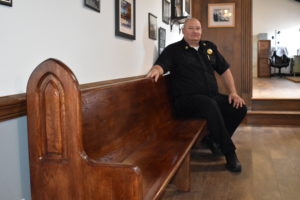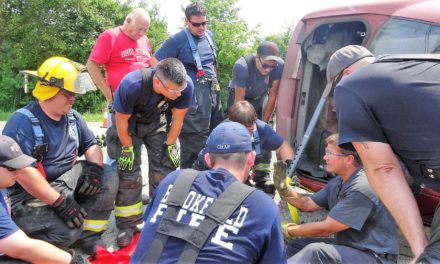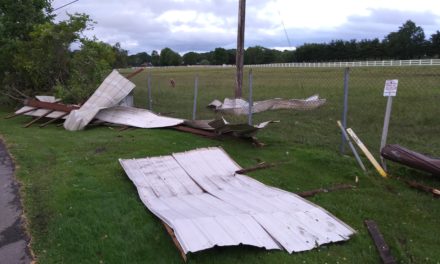
Brookfield Fire Chief David Masirovits sits on the bench he reworked for use at fire Station 18.
David Masirovits is not a master woodworker by any means – his words – but he loves refinishing and repurposing old or well-used wood pieces and bringing them to new life.
The Brookfield fire chief has been spreading his talents throughout the fire house, redoing the oars and seats in the department’s boat; building a shadow box to commemorate the department’s response to the St. Patrick’s Church fire in Hubbard; removing the industrial metal desk from the radio room and replacing it with an oak desk and chairs, adding a homey touch for one-on-one meetings or for firefighters
who are studying for a new certification.
But, there’s one piece he has added that is his favorite, and reflects the personal transformation he went
through as he navigated the department through the COVID-19 pandemic.
The story begins in the middle of the pandemic.
“Because of the situation with the pandemic, and the copious amounts of information that needed to be
disseminated daily to each member of the department, we began to utilize our upstairs conference room at
the fire house as our point of assembly each day,” the chief said at the May 23 memorial service for
members of the police and fire departments and ladies auxiliary. “The men and women of the department
dubbed it the ‘COVID War Room.’ It was here that we talked, laughed, made decisions, cried, and dealt
with the culminations of the pandemic.”
The room had a large table and chairs, but to better serve its daily purpose, it soon included a video
screen, a dry erase board, connections for computers, overhead projectors and maps.
One thing was missing: a bench for overflow seating. Masirovits started looking for a bench in December.
In February, he learned of a church in Youngstown that had closed and was getting rid of its pews. By the
time anyone responded to Masirovits’ phone call, the pews had been sold. But, the caller said, “if we knew
somebody that did woodworking, they had a few scrap benches they couldn’t sell because they were in
really bad shape and were mismatched.”
Masirovits met the church groundskeeper, who led him to where the scraps were stored.
“I picked through quite a few different pieces of wood, and found some that might match up,” Masirovits
said. “I selected what I thought would make a suitable bench. We carried these pieces back through the
halls, and we would stop occasionally to rest. There, the gentleman would share a story or two with me
about the history of the place of worship.”
When the chief got the pieces back to his shop, he began to feel that history. Not at first, as he started
thinking that maybe he had made a mistake.
“It sat there for a few days and the more I looked at the pile, the more I believed it would be possible to
bring to life a suitable bench,” he said. “I began to measure, cut, glue, nail, join and screw pieces together.
 Finally, I had a decent bench. Now, it was time to take on the task of sanding it down and staining it to match our décor. That part didn’t make me nervous in the least. I had plenty of practice on my side. This
Finally, I had a decent bench. Now, it was time to take on the task of sanding it down and staining it to match our décor. That part didn’t make me nervous in the least. I had plenty of practice on my side. This
is where I realized that the project was looking for me, not vice versa.”
Masirovits started with the back rest.
“This area cleaned up with ease to reveal a beautiful wood grain with a nice, smooth, even surface,” he said. “I was excited and thought how easily this project was going to go.”
The seating area was another story. No matter what kind of sandpaper he used, or pressure he applied, it
just didn’t work the way he hoped.
“I was frustrated how uncooperating this bench was becoming,” he said.
He ended up burning up his sander, and a new one fared no better.
“It was then I realized the areas that gave me the worst times were the areas where a person’s body would
be if they were praying,” Masirovits said. “The bench began to tell the story of where it had been. The
arm rests, where one’s hand would go, were worn through to the bare wood, but smooth and stained by
sweat and oil. You could almost feel the tight grip that many people had on the wood as they prayed
many, many times. The seat, where your back of your thighs would rest, had a pronounced roundness
over the edge, where people would fall to their knees, begging for God’s mercy and forgiveness. And the
top and back of the seat, where the person in the pew behind would grip and lean to pray for God’s
presence. I then realized why it was so hard to remove the finish and prepare this new bench for new life
– it was because this bench had stories.”
This bench held the prayers of those who had used it.
“It had prayers for help, prayers for wellness, prayers out of frustration, for health, forgiveness,
acceptance, prayers of despair and thankfulness, prayers surrounding births, baptisms, weddings, funerals,
rituals and rites, prayers asking God to not let go, begging for his understanding, his grace and his
blessing.”
Masirovits questioned his undertaking of the project.
“Was I erasing these devotions, these heartfelt pleas and invocations?”
He said his own prayer and an answer came back: “A harmony of knowing that, by breathing new life
into this bench and repurposing it, will give it new meaning. It will give it a new significance. It will
allow for those forward whom sit upon it to each time bring to it a new definition and statement of
meaning, all the while allowing it to show its history simply by design.”
The bench’s new meaning symbolizes the new meaning that those who sit upon it can give themselves as
they emerge from the negative emotions brought on by the pandemic.
“Just like the bench, we may be broken, but it doesn’t mean we can’t be fixed,” the chief said. “We, like
the bench, can be stained, not in the same sense, necessarily, but stained like a scar. If we, like the bench,
with a little elbow grease, can be sanded, we can move from the things that keep us in the past. We can
put on a shiny lacquer finish, not to hide our blemishes, but to once again shine. I implore each of you to
pick up where we are today, sand yourself down, put on a new, shiny coat, and gleam. Let your grain,
your design and your beauty tell the story of where you have been and where you come from.”








